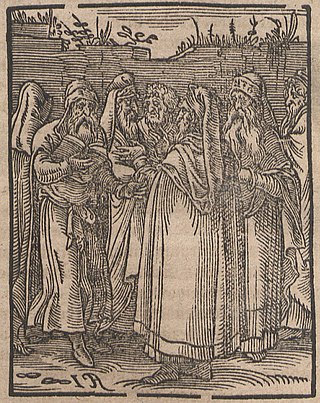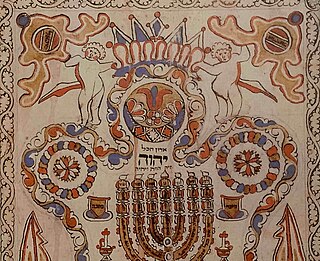Related Research Articles

Kabbalah or Qabalah is an esoteric method, discipline and school of thought in Jewish mysticism. A traditional Kabbalist is called a Mekubbal. The definition of Kabbalah varies according to the tradition and aims of those following it, from its origin in medieval Judaism to its later adaptations in Western esotericism. Jewish Kabbalah is a set of esoteric teachings meant to explain the relationship between the unchanging, eternal God—the mysterious Ein Sof —and the mortal, finite universe. It forms the foundation of mystical religious interpretations within Judaism.

Moses ben Maimon (1138–1204), commonly known as Maimonides and also referred to by the acronym Rambam, was a Sephardic Jewish philosopher who became one of the most prolific and influential Torah scholars of the Middle Ages. In his time, he was also a preeminent astronomer and physician, serving as the personal physician of Saladin. Born in Córdoba within the Almoravid Empire, on Passover eve, 1138, he worked as a rabbi, physician and philosopher in Morocco and Egypt.

Isaac ben Solomon Luria Ashkenazi, commonly known in Jewish religious circles as Ha'ari, Ha'ari Hakadosh or Arizal, was a leading rabbi and Jewish mystic in the community of Safed in the Galilee region of Ottoman Syria, now Israel. He is considered the father of contemporary Kabbalah, his teachings being referred to as Lurianic Kabbalah.

Keter also known as Kether, is the topmost of the sephirot of the Tree of Life in Kabbalah. Since its meaning is "crown", it is interpreted as both the "topmost" of the Sephirot and the "regal crown" of the Sephirot. It is between Chokhmah and Binah and it sits above Tiferet. It is usually given three paths, to Chokhmah, Tiferet and Binah.

Tammuz, or Tamuz, is the tenth month of the civil year and the fourth month of the ecclesiastical year on the Hebrew calendar, and the modern Assyrian calendar. It is a month of 29 days, which occurs on the Gregorian calendar around June–July.

Moses ben Jacob Cordovero was a central figure in the historical development of Kabbalah, leader of a mystical school in 16th-century Safed, Ottoman Syria. He is known by the acronym the Ramak.

In the branch of Jewish mysticism known as Kabbalah, Daʻat or Da'ath is the location where all ten sefirot in the Tree of Life are united as one.

Joel ben Samuel Sirkis also known as the Bach, was a prominent Ashkenazi posek and halakhist, who lived in central Europe and held rabbinical positions in Belz, Brest-Litovsk and Kraków, and is considered to be one of the greatest Talmudic scholars of Poland. He is known for his liberal rulings in his responsum in which he challenges the rabbinic status quo.

Eliyahu de Vidas was a 16th-century rabbi in Ottoman Palestine. He was primarily a disciple of Rabbis Moses ben Jacob Cordovero and also Isaac Luria. De Vidas is known for his expertise in the Kabbalah. He wrote Reshit Chochmah, or "The Beginning of Wisdom," a pietistic work that is still widely studied by Orthodox Jews today. Just as his teacher Rabbi Moses Cordovero created an ethical work according to kabbalistic principles in his Tomer Devorah, Rabbi de Vidas created an even more expansive work on the spiritual life with his Reishit Chochmah. This magnum opus is largely based on the Zohar, but also reflects a wide range of traditional sources. The author lived in Safed and Hebron, and was one of a group of prominent kabbalists living in Hebron during the late 16th and early 17th-century.
Hayyim ben Joseph Vital was a rabbi in Safed and the foremost disciple of Isaac Luria. He recorded much of his master's teachings. After Vital's death, his writings began to spread and led to a "powerful impact on various circles throughout the Jewish world."

Moses ben Joseph di Trani the Elder, known by his acronym Mabit was a 16th-century rabbi in Safed.

Tomer Devorah was written in Hebrew in the middle of the 16th century by Moses Cordovero, a Jewish kabbalist in Safed, Ottoman Syria. This short text deals mostly with the Imitation of God through the acquisition of divine traits, especially those of the sephirot. The first edition was published in Venice in 1588. Although not widely read among Jews today, it is popular in the mussar tradition, which focuses on the individual cultivation of the middot, or qualities of God.
Abraham ben Mordecai Galante was an Italian kabbalist born in Rome at the beginning of the 16th century. Abraham, like his father Mordecai and his brother Moses of Safed, is represented by his contemporaries as a man of high character who led a holy life. Being wealthy, he erected a splendid mausoleum over the tomb of Simon ben Yoḥai at Meron, which is still admired.
Lurianic Kabbalah is a school of kabbalah named after Isaac Luria (1534–1572), the Jewish rabbi who developed it. Lurianic Kabbalah gave a seminal new account of Kabbalistic thought that its followers synthesised with, and read into, the earlier Kabbalah of the Zohar that had disseminated in Medieval circles.
Christian Kabbalah arose during the Renaissance due to Christian scholars' interest in the mysticism of Jewish Kabbalah, which they interpreted according to Christian theology. It is often transliterated as Cabala to distinguish it from the Jewish form and from Hermetic Qabalah.

A Garden of Pomegranates is a 160-page book, written by Israel Regardie in 1931.

Menahem Azariah da Fano was an Italian rabbi, Talmudist, and Kabbalist.
Moses, Moishe, Moshe, Musa (Arabic:موسی), or Movses is a male given name, after the biblical figure Moses.
Atzmus/atzmut is the descriptive term referred to in Kabbalah, and explored in Hasidic thought, for the divine essence.
Pardes Rimonim is a primary text of Kabbalah composed in 1548 by the Jewish mystic Moses ben Jacob Cordovero in Safed, Galilee.